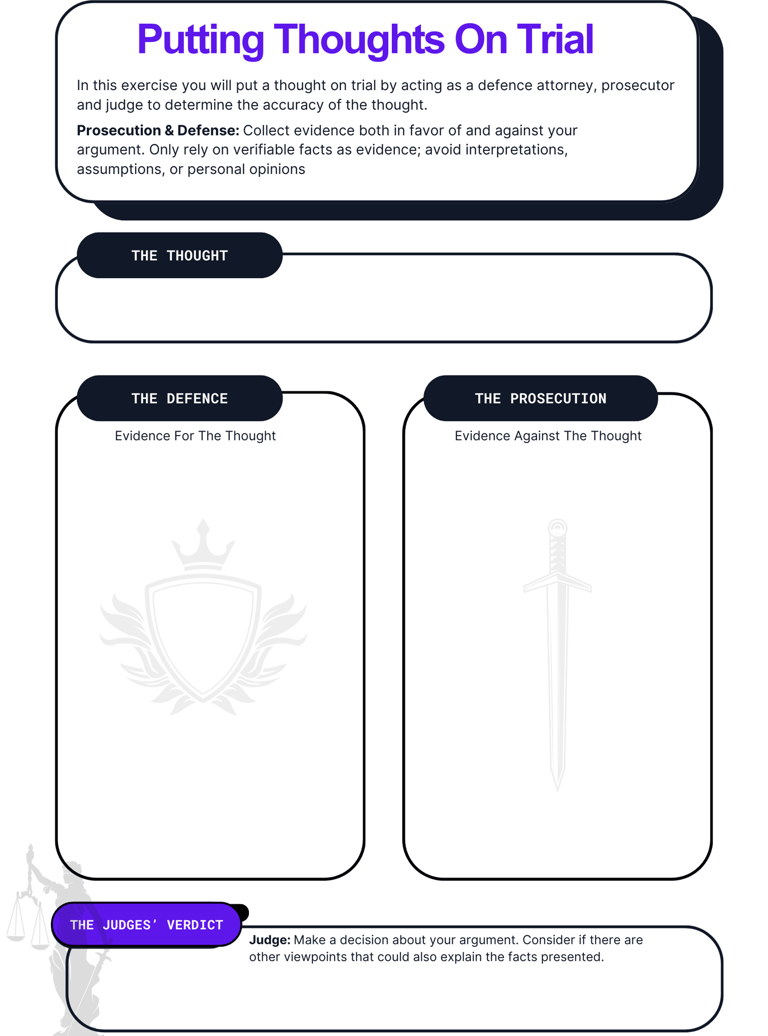Its Time to Lawyer Up: A Guide to Squashing ANTs and Thinking Traps
A practical guide to managing irrational and automatic negative thoughts
MENTAL HEALTH TOOLSANXIETYEMOTIONSQUIZZESTHINKING TRAPS


Ever feel like your brain is a playground for negative thoughts? Don't worry, you're not alone! ANTs (Automatic Negative Thoughts) and thinking traps are like sneaky bugs that can infest our minds, whispering doubts and anxieties. In this guide, we'll equip you with a simple five-step process to stomp out those ANTs and reclaim your mental peace.
Step 1: Catch The A.N.T
When a negative thought pops up and triggers a bad feeling, hit the pause button. Instead of letting it run amok, ask yourself: "Is this an ANT trying to trick me? Is my mind playing a thinking trap game?" Be your own detective, recognizing the signs of distorted thinking.
ANTs can take various forms, such as:
Black and white thinking: Seeing things as either all good or all bad, with no middle ground.
Overgeneralization: Making sweeping conclusions based on a single event or experience.
Mind reading: Assuming you know what others are thinking, usually assuming the worst.
Catastrophizing: Blowing things out of proportion and expecting the worst-case scenario.
By identifying these ANTs, you can begin to challenge their validity and regain control over your thoughts.
Step 2: Lawyer up!
Imagine yourself as a lawyer, building a case for and against your thoughts. Gather evidence for both sides:
Prosecutor Argument: Find evidence that supports what you're thinking. Did you really mess up that presentation? Is your boss truly out to get you? Be honest, but don't jump to conclusions.
Defense Argument: Look for evidence that challenges your negative belief. Did you give your best at the presentation? Could other factors have contributed to your boss's feedback? Be your own advocate!
Step 3: Judge & Jury In One
Now, put on your judge hat. Weigh the evidence you gathered in both arguments. The side with the strongest case wins, representing a balanced and likely true thought. The weaker side loses, revealing a cognitive distortion – a thinking trap not based on reality.
Step 4: Verdict & Action
If your thought is a thinking trap, it's time to issue a verdict:
Acknowledge it: Acknowledge the trap and rewrite the thought with a more balanced perspective "This is a thinking trap trying to trick me."
Reframe it: Rewrite the thought with a balanced perspective.
Release it: Sometimes, the best action is to let go. If the thought is clearly a trick of your mind, say "Not today, ANT!" and focus on something else.
Example:
Instead of: "I failed this test, I'm a total loser."
Reframe: "I didn't prepare well for this test, but I can learn from my mistakes and do better next time."
Release: "This thought isn't helpful, I'm letting it go and focusing on studying smarter."
Example 2: Instead of "I'm a failure," try "I made some mistakes, but I'm learning and growing."
But what if your thought, while negative, seems to have some basis in reality? Don't panic!
If the thought is balanced:
Acknowledge it: "This seems to be a true reflection of my situation."
Silver lining: Look for potential lessons or positive aspects.
Solution focus: If possible, brainstorm solutions to address the situation.
Understanding: Seek explanations that offer a different perspective.
In summary, accept the truth, but look for the hidden potential. Maybe a low work evaluation is a chance for improvement or a nudge toward a new career path. Instead of dwelling on the problem, brainstorm solutions. Can you talk to your boss, seek help, or implement new strategies? Remember, even difficult truths can lead to positive action.
Step 5: Hung Jury? No Problem
Sometimes, the jury (you) may remain undecided or the negative thoughts stick around even after you challenge them. If you can't reach a verdict or keep ruminating on a thought, Don't get discouraged! Here's what to do:
Take a Break: Give your mind a rest. Distract yourself with activities you enjoy, exercise, or spend time in nature. A change of scenery can work wonders.
Body to the Rescue: Sometimes, physical movement can help shift your mental state. Try yoga, dancing, or even a brisk walk. Engaging your body can shake loose those pesky A.N.Ts.
Ask someone for help: Share your struggles and successes with a trusted friend, family member, or therapist. They can offer support and guidance on your journey to mental clarity.
Conclusion
Remember, you don't have to face ANTs and thinking traps alone. Reach out to trusted friends, family members, or professionals for support. Sometimes, talking through your thoughts and feelings with someone else can provide a fresh perspective and help you gain clarity.
Consider seeking therapy or counseling if negative thoughts and thinking traps are significantly impacting your daily life and well-being. A trained professional can provide guidance and techniques tailored to your specific needs.
Additionally, there are numerous self-help books, online resources, and support groups available that can provide valuable tools and strategies for overcoming ANTs and thinking traps.


